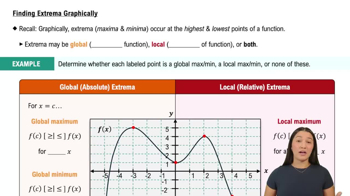Table of contents
- 0. Functions7h 52m
- Introduction to Functions16m
- Piecewise Functions10m
- Properties of Functions9m
- Common Functions1h 8m
- Transformations5m
- Combining Functions27m
- Exponent rules32m
- Exponential Functions28m
- Logarithmic Functions24m
- Properties of Logarithms34m
- Exponential & Logarithmic Equations35m
- Introduction to Trigonometric Functions38m
- Graphs of Trigonometric Functions44m
- Trigonometric Identities47m
- Inverse Trigonometric Functions48m
- 1. Limits and Continuity2h 2m
- 2. Intro to Derivatives1h 33m
- 3. Techniques of Differentiation3h 18m
- 4. Applications of Derivatives2h 38m
- 5. Graphical Applications of Derivatives6h 2m
- 6. Derivatives of Inverse, Exponential, & Logarithmic Functions2h 37m
- 7. Antiderivatives & Indefinite Integrals1h 26m
- 8. Definite Integrals4h 44m
- 9. Graphical Applications of Integrals2h 27m
- 10. Physics Applications of Integrals 2h 22m
5. Graphical Applications of Derivatives
Intro to Extrema
Problem 4.1.25
Textbook Question
Locating critical points Find the critical points of the following functions. Assume a is a nonzero constant.
ƒ(x) = x³ / 3 - 9x
 Verified step by step guidance
Verified step by step guidance1
To find the critical points of the function \( f(x) = \frac{x^3}{3} - 9x \), we first need to find its derivative, \( f'(x) \).
Differentiate \( f(x) \) with respect to \( x \). The derivative of \( \frac{x^3}{3} \) is \( x^2 \), and the derivative of \( -9x \) is \( -9 \). Therefore, \( f'(x) = x^2 - 9 \).
Set the derivative \( f'(x) = x^2 - 9 \) equal to zero to find the critical points: \( x^2 - 9 = 0 \).
Solve the equation \( x^2 - 9 = 0 \) for \( x \). This can be factored as \( (x - 3)(x + 3) = 0 \), giving the solutions \( x = 3 \) and \( x = -3 \).
The critical points of the function are \( x = 3 \) and \( x = -3 \). These are the values of \( x \) where the derivative is zero, indicating potential local maxima, minima, or points of inflection.
 Verified video answer for a similar problem:
Verified video answer for a similar problem:This video solution was recommended by our tutors as helpful for the problem above
Video duration:
5mPlay a video:
Was this helpful?
Key Concepts
Here are the essential concepts you must grasp in order to answer the question correctly.
Critical Points
Critical points of a function occur where its derivative is either zero or undefined. These points are essential for identifying local maxima, minima, and points of inflection. To find critical points, one must first compute the derivative of the function and then solve for the values of x that satisfy the condition of the derivative being zero.
Recommended video:

Critical Points
Derivative
The derivative of a function measures the rate at which the function's value changes with respect to changes in its input. It is a fundamental concept in calculus that provides information about the slope of the tangent line to the function at any given point. For the function given, the derivative will help identify where the function's behavior changes, leading to the determination of critical points.
Recommended video:

Derivatives
Local Extrema
Local extrema refer to the highest or lowest points in a particular interval of a function. These points are found at critical points where the derivative is zero or undefined. Understanding local extrema is crucial for analyzing the behavior of functions, as they indicate where the function reaches its maximum or minimum values within a specified range.
Recommended video:

Finding Extrema Graphically

 5:58m
5:58mWatch next
Master Finding Extrema Graphically with a bite sized video explanation from Callie
Start learning




